So I thought I’d post just a little bit more about the 1938 Marie Antoinette sorta-rocket dress.
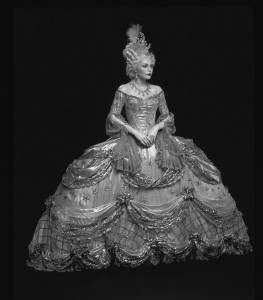
I didn’t take very many pictures while I was making the dress, because I wasn’t blogging about it and I was focused on just getting it done! But I did take a few photos that show a bit of the process, plus I’ve finally gotten the official con photos of the outfit, and I gotta post those!

I used Simplicity 3635 — I know! — for the pannier. I looked at the diagrams in Norah Waugh’s Corsets & Crinolines and Jean Hunnisett’s Period Costume for Stage & Screen, and found that they were really similar. The only real tweak I made to the Simplicity pattern is that I put boning in the bottom hoop. If you look at the pattern image, you’ll see the pattern breaks off around mid-calf, which I think would look really ugly underneath a skirt! Plus, I’m 5’11”, and I can use all the length I can get.
Because I am cheap and couldn’t stomach the thought of paying for all that hoop wire, I ended up using 3/8″ half-round caning from the Caning Shop, which was super cheap! I was, however, terrified that it would break, particularly when packing the giant hoop o’ doom into the car for the drive down to Costume College. So I ended up doubling the cane in each casing, which worked out great in terms of supports — no cracking, breaking, etc. One thing I did that you may want to avoid, however, is I initially thought that the half-round cane should go into the casing flat side to flat side, so that it would make one whole round — I thought a flat side against curved side might lay weird. Well, I found that the cane wants to go around with its natural bend, and when you put the second piece in flat to flat, you’ve got one piece of cane that is trying to bend against its natural curve — and things go wonky! It didn’t curve nicely and ended up sort of warped looking. So I pulled it out and put it back in, flat side to round side, both pieces curving along their natural curve, and it all laid fine and made a lovely shape.
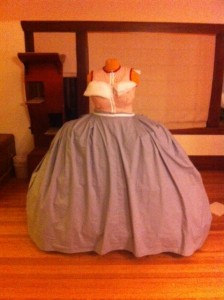
I wasn’t sure whether I’d need a petticoat to avoid the individual hoops sticking out, but I decided to make the skirt first and see if I needed one. I made a base skirt of grey cotton, because in looking at the original dress, I misread the top lace swags as a separate piece, not just applied swags like the lower pieces. I used Katherine/Koshka’s 18th c. court skirt tutorial to start, although I had to do a lot of futzing to get the end pleats to hang where I wanted them. It was REALLY hard to level the skirt given that my dress form was a floor model and so has a decided lean and rickety-ness to it! I ended up marking one side, and then matching the other side to those markings, and crossing my fingers.
The pannier/skirt was SO huge, I had to move it all into the living room while I was working on it. Luckily my husband was out of town for about 5 days, so I was able to take over! Unfortunately, the dogs discovered the joys of “I hide under the skirt and get you,” so I had to swat them away. A lot.
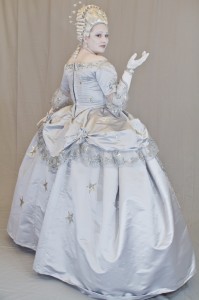
I attached the satin skirt to the cotton underskirt. The base of the satin goes up to about where the hoop starts to go down rather than out. The cotton underskirt and upper satin skirt are all sewn into the same waistband.
The lace around the overskirt is cut from that same yardage and hemmed. I made the flowers from the same satin, after trying to find some vintage silver flowers (no dice) or modern fabric flowers that weren’t cheesy (ditto).
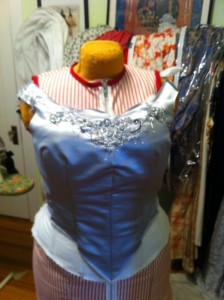
This is the only in-progress photo I took of the bodice, which is very Victorian in approach. I tried to follow the lace layout on the original, cutting motifs out of the lace yardage I had and hand sewing them to the bodice.
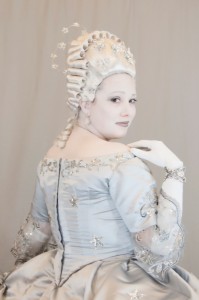
The bodice closure uses the technique found in most 18th c. court dresses, where the bodice and lining are separate for about 1-2″ along the center back. Lacing holes are put into the lining layer, and therefore don’t show through the fashion fabric.
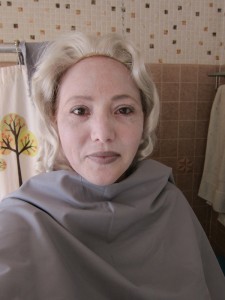
I did a number of makeup tests with Leia, which didn’t start off too well. We read a number of posts on Cosplay.com, and most everyone recommended Kryolan Aquacolor. Although we planned to use grey, I had some white on hand that I messed with… and I swear, anything more than the first layer seen above made me look like I was covered in calamine lotion. NOT good. And one layer left a lot of pink showing through.

Luckily there’s a Kryolan store here in San Francisco, so I went in for help, and they showed me Supracolor, which is an oil-based makeup and therefore SO easy to apply! It goes on smooth and moist, and you can mix colors easily on your skin or beforehand (I mixed white with black to get grey), and it’s very moveable until you set it with powder and setting spray. The rest of my makeup I did with standard makeup — grey and white eyeshadows and a grey eyeliner. I’m a lip balm addict, and was REALLY worried about putting something drying on my lips and having to not touch it all night. I ended up covering my lips thickly with my usual lip balm, and then coloring over that with the grey eyeliner, which actually made a bit of a lipstick-y paste… and I managed to go all night without wanting to rip my lips off and dunk them in a bath of Burt’s Bees, which is saying something! (Come on, fellow lip balm addicts, you know you feel me).
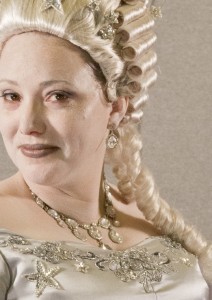
I was super excited about my jewelry. The necklace is FABULOUS and, shockingly, came from H&M a year or so ago, a present from the fabulous Trystan. A couple of people asked about the matching rhinestone bracelets I wore, which were dirt cheap (like $4-5 each with free shipping!) from Alilang on Ebay. And this was the first wearing of my SUPER-EXCITED-ABOUT QVC Marie Antoinette earrings, which are amazing reproductions of a real pair of Marie Antoinette’s earrings, conserved at the Smithsonian.
And lastly, a few more official photos!
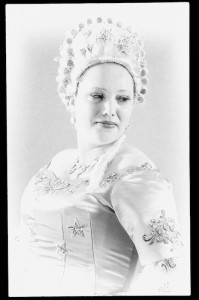

That is just divine! The professional photos are gorgeous!
And if you ever get tired of the earrings, I wouldn’t mind taking them off your hands… 😉
You made a wonderful job! Absolutely lovely!
You really were amazing, Kendra, the true Queen. Great job.
Jaw dropping costume! Can’t wait to see what you come up with next!